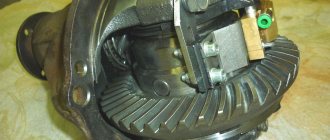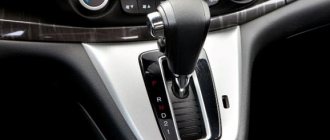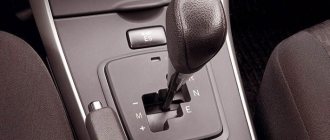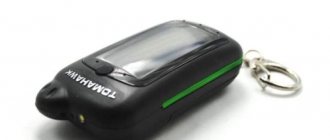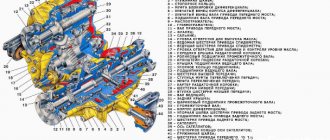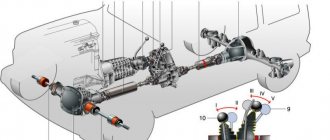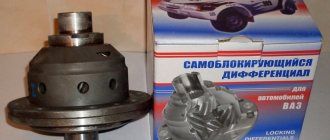Using a transfer case
general information
The transfer case is designed to distribute torque between the front and rear axles of the car.
The transfer case mode switch lever is located in the lower part of the center console, behind the gear shift lever (Manual transmission)/selector lever (AT). On models with manual transmission, the lever allows you to select one of four transmission modes: 2H, 4H, (N) and 4L, on models with AT - one of three: 2H, 4H, and 4L.
On models equipped with vacuum freewheels, switching between 2H and 4H modes can be done directly while the vehicle is moving at low speed (up to 40 km/h), and there is no need to depress the clutch on models with manual transmission.
To activate the 4L mode, you must completely stop driving, depress the foot/parking brake, depress the clutch (models with manual transmission)/move the selector lever to the “N” position (models with AT), then carefully shift the transfer case lever to position 4L (models with AT )/first to position N, then to position 4L (models with manual transmission).
Assignment of transfer case mode switching lever positions
N
— Only on models with manual transmission.
In the neutral position of the transfer case, the drive of both axles is disabled. The indicator light built into the instrument cluster (see Section Instrument cluster, meters, warning lamps and indicator lights
) is also turned off.
2H
— Transfer case main mode. The drive is carried out only on the wheels of the rear axle. The indicator light is off.
4H
— The drive is carried out on the wheels of both axles. The indicator light is on. The mode is intended for driving on roads with slippery or loose surfaces (snow, mud, sand), as well as when the wheels lose traction while driving in 2H mode.
4L
— All four wheels are driven, the transfer case gearbox is switched to a downshift. The indicator light is on. Maximum wheel grip and maximum traction force are ensured. It is recommended to navigate through areas covered in deep snow/mud/sand, particularly steep inclines/descents, and when towing heavily loaded trailers. The mode is not intended for long-term use.
Niva is a car that has been produced since 1977. It differs from other domestic cars in that it has permanent all-wheel drive. Few car enthusiasts know what this means, although they have heard a lot about this feature of the vehicle; a diagram of the device can easily be found on the Internet. All-wheel drive in the Niva is equipped for all 4 wheels, and the center differential is locked. The mechanism consists of a gearbox, a transfer case designed for 2 stages, and cardan shafts located in the front and rear of the machine. This also includes the front and rear axles.
When the engine starts to rotate, an impulse is sent to the gearbox and transfer case, after which the torque is distributed to the front and rear axles simultaneously. Afterwards, the gearboxes are activated, and behind them the front and rear wheels of the Niva begin to rotate. Torque causes 4 wheels to rotate at once, which is why it is called full torque. But the rear wheels still drive.
Why does Niva need blocking?
Wheel differential is a mechanism that allows a car to rotate its wheels at different speeds, which does not mean changing gears, but changing when cornering, when one wheel describes a small diameter and the other a large circle. In the absence of a differential, the wheels in the Niva would begin to slip, which could result in damage and rapid wear of the rubber.
When the vehicle moves on a flat road surface, the thrust from the engine is distributed evenly to the 4 wheels.
When at least one wheel slips, which often occurs on an icy road, the differential puts more force on the slipping wheel. In other passenger cars, such a device involves installation on a drive-type axle. Niva has it in other areas:
- on the rear and front axles;
- in the center between the axles, located near the gearbox and axles.
Useful video
As you can see, there is nothing supernatural in dismantling the unit. The only requirement is access to the underside of the car. This simplicity is ensured by the design of the VAZ Niva and its adaptability to operation in harsh conditions.
The Niva family of cars differs from VAZ passenger cars in permanent all-wheel drive - they have two drive axles. In total, the VAZ SUV has three differentials in its transmission - one for each axle and another center differential.
The Niva transfer case is designed to distribute traction forces between axles, and operates on the principle of a 2-speed gearbox.
How to enable differential lock on Niva
The Niva and its various modifications allow you to operate 3 differentials at once. Thanks to this factor, the vehicle’s cross-country ability increases significantly when driving in rural areas. The forced locking format involves connecting the driving wheels together, causing them to spin at different speeds. This approach allows you to use the maximum possible traction characteristics of the engine, which are transmitted to the wheels.
To lock the differential on the Niva, the manufacturer has provided a clutch for the locker. When forced locking is turned on, the wheels become interconnected and rotate in the same mode. When the inter-axle lock is activated, the axles located at the front and rear interact and distribute traction to all wheels. This mechanism is easy to use, which is confirmed by the unique cross-country ability of the Chevrolet Niva.
When to use and how to disable blocking
It is preferable to enable forced blocking in various modifications of the Niva in the following situations:
- The blocking must be turned on in advance if you have to overcome a difficult route.
- On sharp climbs uphill or when driving downhill.
- While crossing terrain with a top layer of sand.
- When you have to drive on snow drifts or an icy road.
Wheel locking is not necessary when driving quietly on a flat road within the city. Grip on asphalt surfaces will be decent, and traction will be distributed evenly by default.
Rules for applying blocking on Niva
To ensure that the locking mechanism lasts for a long time, use the following rules:
- It is necessary to switch the transfer case when the Niva does not move.
- The differential can also be engaged while the vehicle is moving.
- To ensure efficient and long-term operation of the device, it is advisable for the Niva driver to turn on the lock from time to time. Once a week in winter is enough.
Where is the lever responsible for switching located? Pay attention to the area between the wings located in front, there are 2 levers there. One makes it possible to change gears at the gearbox, the other successfully controls the transfer case.
The basis of the transfer case is a gearbox, which includes 2 stages. The control lever comes directly from it, you can move it forward and backward - this is how the gear is changed on the Niva. The direction of movement of the lever to the left and right allows you to activate the differential lock and vice versa to disable it.
Elements of transfer case 2121
The multiplier is installed only on VAZ models with 2 drive axles. Located behind the gearbox. A driveshaft is mounted on the transfer case itself. Basic elements that are present in all models of Soviet-made demultiplicators:
- frame;
- intermediate and drive shafts;
- set of bearings and gears;
- satellites;
- drive shafts of the front and rear axles;
- oil seals, flanges, couplings;
- differential;
- control and control levers.
The connection between the unit and the gearbox is rigid, which is carried out through a coupling and a shaft. The transfer case of the VAZ 21214 model differs from the classic one only in the presence of a speed sensor drive.
Why is downshift needed?
It is difficult to imagine a transfer case without the main functional component - a reduction gearbox. Positioning the lever in the rear direction reduces the transfer case value to 1.2.
By fixing the lever at the front, the gear ratio can be increased to 2.1. The lever in neutral indicates gear ratio 0.
To use the lock installed on the Niva effectively, use the following recommendations from experts:
- When driving on good quality road surfaces, install the front transfer handle at the front and the rear at the rear.
- The front handle is moved back if the road becomes slippery. Once the slippery area has been passed, switch the levers to normal mode.
- If the Niva is stopped, the lock may not engage when the clutch is depressed. This occurs due to the alignment of the teeth with the gear teeth. What should you do in this case? Moving as if on a turn, engage the lock. The differential will turn and the gear teeth will come closer to the teeth. If turning off is difficult, do it while the vehicle is moving, maintaining a minimum speed and squeezing the clutch.
How the cross-axle differential lock works on a Niva is clearly shown in the video:
Alas, not everyone knows how to use the transfer case on a Niva Chevrolet. Before we begin the analysis of this topic, it should be noted that this car is an excellent option not only for adrenaline junkies, but also for people who use the vehicle specifically for driving in urban environments. Everyone knows that there is a transfer case here. It is good because it allows you to perform several important operations with one movement of the lever. To use a lower gear, the lever is moved to the right side and then goes up. It is logical that for an increased one it is simply retracted back. Many will be surprised, but using the transfer case, you can turn the car into neutral. This is a good opportunity to keep the vehicle in one place. The lock is easily engaged in both high and low gears. You just need to move the lever to the left.
Downshifting - how is it done?
How to use the transfer case on a Niva Chevrolet? What's the point of engaging the lock and downshifting? The questions seem simple, but quite serious. However, everything is very simple. Just imagine driving down the road in fifth gear. Everything is fine, including the quality of the road surface, but suddenly a huge puddle appears in front of the driver. It is clear that if the car gets into it, it will simply drown. To avoid this, you need to stop and change from a higher gear to a lower gear. Yes, you really need to slow down completely.
The point is the presence of a differential located between the two axles. Its presence will not make it possible to immediately switch from upshift to downshift and, accordingly, back. So what's the point of having a low gear?
Again, you should imagine a situation where you need to overcome a very dirty section of the road. The car is moving in third gear. The driver understands that the vehicle has difficulty overcoming such obstacles. The time comes to switch to first gear, but this does not give the desired effect. Actually, in such a situation, a lower gear comes in handy.
In simple terms, this is a small half of the usual first. You can guess that the second lowered one is a simple first one. It is generally believed that a low gear is ideal for driving on bad roads. Having turned it on, you should not press the accelerator pedal sharply, because at this very moment the wheels will be overloaded, and this will lead to the formation of a hole. Naturally, further movement will be impossible. In such a situation, the car provides the driver with the chance to feel as accurately as possible how the wheels rotate. If they suddenly begin to sink into the ground, this can be understood by their uneven movement. Now the main thing is to notice in a timely manner that problems have arisen while there is an opportunity to correct the situation. Alternatively, you can try to change the direction of movement.
If the vehicle is driven through puddles or sticky ground, never shift to second downshift. Increasing the torque, the car can simply “choke”. Simply put, it will be difficult to drive and this will lead to the engine stopping working at the most critical moment.
The driver can drive in third reduced gear. If there is a feeling that the car is having a hard time coping with the load, then it is better to switch to simple first or second, which will also prevent it from stalling, as in the previous case.
Why is the blocking activated?
The all-wheel drive vehicle is designed specifically to overcome the most difficult obstacles. The described iron horse is the ideal SUV. The available lock allows you to make the machine as powerful as possible. At the moment when the locking is activated, those wheels that are easier to do this are switched on.
Including blocking, most often, the two bridges begin to function at half their maximum capacity. In fact, one wheel spins on the front axle and on the rear.
The issue under discussion is relevant in the case when the vehicle begins to slip immediately at the moment when the lock is turned off. In such a situation, it is the stuck wheels that slip. Alas, they begin to sink even further into the ground. As soon as the blocking begins to function, the non-stuck wheels are put into operation and thus pull the car out of the mud.
After reading this article, it becomes clear why a transfer case is needed. In some situations it will really be difficult without it. I would like to believe that now everyone knows and understands how to use the transfer case on a Niva Chevrolet. There is absolutely nothing complicated about this, but in order to avoid difficulties, you should read this material as carefully as possible.
All SUVs differ from ordinary cars in that such vehicles can overcome any obstacle on the road, even when there is no road at all. These cars received this feature due to the presence of all-wheel drive, which can be either permanent or connected.
All-wheel drive is driven by differentials. Chevrolet Niva also has one.
This mechanism contains shafts and gears. The differential is intended to distribute torque from the engine to the wheels. In Niva, the main driving wheels are the rear ones. With the help of a differential, the wheels can spin at different speeds
, for example, when cornering. In this case, one wheel travels a small radius, and the other – a large one. If there were no differential, the wheels would begin to slip, which would cause increased tire wear.
Lever location
When driving on a straight road, the thrust from the engine is distributed evenly between the wheels. If one wheel starts to slip, for example on ice, then the differential transfers more force from the engine to it. This mechanism is mainly installed on the drive axle. Niva has it at:
- Rear and front axles.
- Between the axles (central). Located between the gearbox and axles.
Video about how the cross-axle differential lock works on a Niva Chevrolet
Enabling the differential lock
On the Chevrolet Niva it is possible to turn on all three differentials at the same time
. Thanks to this, the vehicle’s cross-country ability increases several times when driving off-road.
Forced locking means that the drive wheels are combined with each other, as a result of which they can rotate at the same speed. Thanks to the blocking, the traction force of the engine will be used to the maximum and transmitted to the wheels.
As already mentioned, the differential assembly consists of shafts and gears. With their help, the traction force is automatically distributed between the drive wheels. The differential is locked using a blocker (clutch)
. In this case, when the driver turns on the forced locking, the wheels “become” connected to each other. This helps ensure that they rotate evenly.
Differential assembly
If the center lock is forcibly engaged, then the front ones are also rigidly connected at once, which guarantees an even distribution of traction to all four wheels. Thus, the vehicle’s cross-country ability will be increased several times.
, which makes the Chevrolet Niva a real SUV.
Applying a lock
Not all cars are equipped with blockers, and therefore they will be vulnerable off-road. In this regard, Chevrolet is a unique car that can move with both one-wheel drive and all-wheel drive.
, which allows him to feel confident even on mountain roads.
To engage the differential lock, pull the lever all the way to the left.
Forced blocking should be enabled in the following cases:
- When overcoming difficult sections of the route. In this case, the blocking should be turned on in advance, even before leaving for such an area.
- On steep climbs or slopes when wheel slip is possible.
- When driving on sand.
- When driving on snow or ice.
Disable blocking
When the Niva moves on a regular road with a smooth surface, it will not need to lock all wheels. They will adhere normally to the surface and not slip, since the traction force from the engine will be distributed evenly over them. For this reason, when the car is moving on a good road where the wheels will not slip, the use of a differential will not be required.
Transfer case alignment
Correct installation of the transfer case can be done in several ways. Most often in auto repair shops, repairmen use the following method:
- hang the car on a lift;
- loosen the transfer case;
- start the engine;
- engage the gear and accelerate the car according to the speedometer to the speed at which vibration occurs (often it occurs at speeds from 40 to 80 km/h);
- without using the brakes, reduce the engine speed, then turn off the ignition.
The transfer case itself is centered in place, all that remains is to tighten the fastenings of the supports.
You can also adjust the position of the RC using a wire; we do it as follows:
- loosen all four fastenings of the transfer case supports;
- fasten one end of the wire to the rubber coupling of the propeller shaft;
- we attach another piece of wire to the CV joint, bring the other ends of the wire to each other;
Rules for using differential
These include:
- Switching the transfer case should only be done when the car is not moving.
- You can also engage the differential while the vehicle is moving.
- You can switch to a lower gear while the car is moving.
- To ensure long-term and uninterrupted operation of the differential, it is necessary to periodically turn it on, especially in winter. This should be done once every 7 days.
Shift lever location
In the interior of the Niva Chevrolet there are two levers between the front seats
. Using one of them you can change gears in the gearbox, and using the other you can control the transfer case.
Differential shift lever
The transfer case is based on a gearbox consisting of two stages
. The control lever comes out of it into the cabin. He can move forward or backward. At the same time, it switches on/off downshift. If the lever is moved left or right, it can turn the differential lock on/off.
Gear shift and transfer case diagram
Downshift: what does it give?
The main component of the transfer case is the reduction gear
.
If the control lever is in the rear position, then the number of transfer cases decreases and is 1.2
.
When the lever is in the forward position, the gear ratio increases. It will already be 2.1
.
When the lever is in the neutral position, the gear ratio is 0
.
The differential is an integral part of the all-wheel drive mechanism in any car. It is recommended to use it only when the car is moving off-road.
Nivov transmission units
The developed Niva transmission turned out to be so successful and efficient that it later became a prototype for the Vitara. This made the new model more adaptable to difficult roads. Niva transmission units can easily meet the requirements of any engine up to 2 liters, so if you want to upgrade, think about the fact that each car has its own capabilities. Many advantages are due precisely to the circuit and design of the transmission.
Niva transmission and its components:
- front-wheel drive;
- front axle;
- wheel grip;
- manual transmission;
- driveshaft (front);
- shaft (intermediate);
- transfer case;
- shift lever;
- center differential and locking lever;
- wheel differentials;
- driveshaft (rear);
- rear axle;
- rear drive.
The design implies the following states:
- unlocked differential;
- locked differential;
- low gear when engaged;
- neutral position;
- top gear engaged.
Video about the operation of the gearbox and the rules for using the Niva Chevrolet differential
Among domestic car enthusiasts, the Chevrolet Niva is a fairly popular SUV that appeals not only to fans of extreme driving, but also to fans of measured driving outside the city. Many people know that one of the features of a car of this brand is the presence of a transfer case in it. Using this unit, you can enable downshifting, locking, or two functions at the same time, depending on the conditions. The question of how the Niva Chevrolet transfer case should be used correctly is of interest to many happy owners of such a vehicle and those who only intend to purchase it.
It should be immediately noted that you can engage both the lock and the transmission at the same time using the Chevrolet lever that changes gears. So, the lever shifts to the right, and then immediately up to engage a lower gear. To switch back to higher, the lever should simply be moved back.
Using a Niva Chevrolet transfer case, in addition to the above, neutral gear is also engaged, while the car will remain reliably in one place. The lock can be engaged at any time - in normal gear, in low gear - just switch the Chevrolet lever to the left.
When to use low gear
For what purposes is a transfer case even needed, when does it make sense to engage the locking and downshift? Such seemingly simple, but at the same time serious questions will become clear when considering the following example. When driving on a country road on a hard surface, fourth gear is engaged. Suddenly, a large puddle with a soft, unreliable surface appears in front of the car. In such an obstacle the car can easily “sink”. To prevent this, you should engage a lower gear and slowly overcome such an obstacle without haste. This gear is designed specifically for driving on soft road surfaces, when even in first gear the car feels “hard”.
It is worth noting that in order to engage a lower gear on a Niva Chevrolet, you need to stop - this is how the car’s differential is designed. But you don’t need to stop at all to turn the lock on and off. But is it worth using such additional and, without a doubt, useful functions of the machine often? Experienced drivers recommend using them in places where the dirt is not located on level ground, but with various potholes and the like.
Thus, the low gear of the Chevrolet transfer case is designed for comfortable off-road driving and overcoming various obstacles. In such a gear you need to drive slowly, you cannot accelerate sharply, because at this moment the wheels will receive a large load, as a result of which a real hole can form, from which it will be very difficult for the car to get out.
With this driving style, the motorist will better feel the movement of the wheels, as a result of which, when they “bury”, as evidenced by the chaotic movement of the car, it will be possible to immediately do something after overcoming the obstacle. Most often, this is done by changing the trajectory of the car.
It is also worth noting that when driving through sticky mud or deep puddles, you should never suddenly engage second downshift. At the same time, the torque increases, as a result of which the car can simply “choke”, stalling at the most inopportune moment.
Tips for owners
To make driving your car comfortable, read some important points:
- The usual, standard arrangement of the front and rear handles is forward and backward, respectively. Movement in this mode can and should be carried out in areas characterized by even and smooth surfaces.
- Locking the differential by switching the front handle to the rear position is best on roads characterized by increased slipperiness. This measure will give Niva stability. It is worth understanding that after overcoming the problem area, the handle will need to be returned to its original position.
- As noted earlier, downshift should be activated before a potential obstacle, but not while the car is already stuck.
- It is worth understanding that activating the lock when the vehicle is stationary is sometimes impossible, even if the clutch is depressed. This may be caused by the clutch teeth hitting the gear teeth. In this case, you can try to activate the lock by starting to drive slowly and make a slight turn. If problems arise with disabling the lock, it is recommended to perform the same procedure with the clutch depressed and the steering wheel slightly rocked.
Why is blocking needed?
SUV class vehicles are a type of car that is not afraid of difficulties and easily overcomes any obstacles. The Chevrolet Niva is no exception; this model is an all-wheel drive car. The presence of a transfer case, which makes it possible to turn on the lock, makes this domestically produced vehicle model even more powerful and reliable when driving off-road. When the lock is turned on, those wheels of the car that are easier to work at the moment begin to work.
As a rule, when the locking is on, both axles of the car work at about half capacity - that is, one wheel of the front axle and one wheel of the rear axle work.
The use of a transfer case greatly helps the motorist in the case when the car begins to slip when the lock is turned off. At the same time, as everyone knows, it is those wheels that are stuck in the obstacle that will slip, burying themselves even more into it. When the lock from the Niva Chevrolet transfer case is turned on, those wheels that have not skidded begin to work, thereby pulling the car out of the mud or any other obstacle onto a normal hard surface.
Knowledge of which gear is best to overcome various obstacles comes with riding experience. The Chevrolet transfer case will greatly help with this, which allows you to engage a lower gear and lock if necessary.
